the place where Paleontology and Paleoanthropology meets Philately
Greece
Fish and human fossils on stamps of Greece
| << previous country | back to index | next country >> |
Contents:
- Country overview
- Philately of Greece
- Official stamps of Greece related to Paleontology and Paleoanthropology
- References
- Acknowledgement
Greece, officially the Hellenic Republic, also known since ancient times as Hellas is a country located in south-eastern Europe, with a population of approximately 11 million. Athens is the nation's capital and largest city, followed by Thessaloniki. Situated on the southern tip of the Balkan peninsula, it shares land borders with Albania to the northwest, the Republic of North Macedonia and Bulgaria to the north and Turkey to the northeast. The Aegean Sea lies to the east of the mainland, the Ionian Sea to the west, and the Mediterranean Sea to the south. Greece has the longest coastline on the Mediterranean Basin and the 11th longest coastline in the world at 13,676 km ( in length, featuring a vast number of islands, of which 227 are inhabited. [R1]
Greece's first postal service was founded in 1828, at the time of Greek independence from the Ottoman Empire.
This initial service continued mail delivery and, later, the issuing of postage stamps until 1970.
It was then succeeded by the Hellenic Post S.A. (abbreviated ΕΛΤΑ), which remains Greece's official postal provider. The first Greek stamps (known as "Large Hermes heads") were issued in 1861. Until 1966, with the exception of a set issued in 1927, all Greek stamps were simply inscribed ΕΛΛΑΣ (Hellas, the country's Greek name).
From 1966 to 1982, the inscription was modified to include both the Greek and Latin versions: ΕΛΛΑΣ-HELLAS. Beginning in 1982, ΕΛΛΑΣ was replaced with ΕΛΛΗΝΙΚΗ ΔΗΜΟΚΡΑΤΙΑ (Hellenic Republic); this inscription is still being used on Greek stamps. [R2]
Official stamps of Greece related to Paleontology and Paleoanthropology: fossils
| 12.05.1979 "International conference on the early Tertiary time in the Mediterranean region" [1] [3] | 15.03.1982 "European Congress of Anthropology in Petralona" [2] [3] | 05.06.2022 "World Environment Day: Geoparks of Greece" [4] |
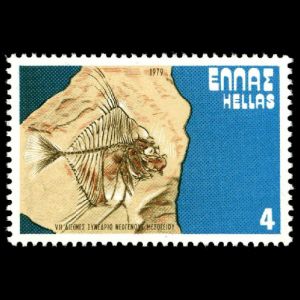 |
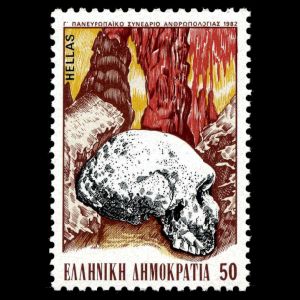 |
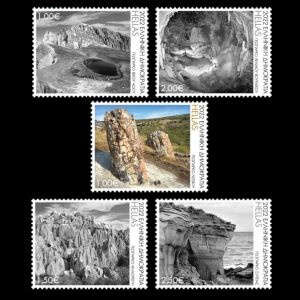 |
Notes:
[1] For the international Conference on the Neogene of the Mediterranean area, Greece Post issued the stamp of a fossil of fish Mene psarianosi symeonidis from early Tertiary time.
This small fish had a body length of 7.5 cm from head to tail
The stamp shows the holotype from the collection of Paleontology and Geology Museum of the University of Athens. [R3]
[2] For European Congress of Anthropology, Greece Post issued the stamp with Petralona skull, dated 200,000 years ago, discovered in 1960 in the Petralona cave near Thessaloniki.
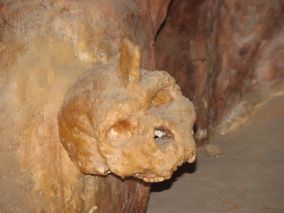
|
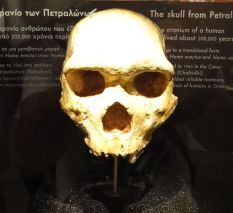
|

|
| Petralona skull covered by stalagmite as it was discovered in the Petralona Cave, near Thessaloniki in Greece. Image credit: Wikipedia | The skull of Petralona. Archaeological Museum of Thessaloniki. Image credit: Wikipedia |
A reconstruction of the skull of Homo petralona as illustrated by Dr. John Hawk.
Dr. Hawk is an associate professor of anthropology at the University of Wisconsin-Madison. In the upper right is a stamp from Greece showing the Petralona skull (Greece, 1982, MiNr: 1480, Scott: 1421). The slide is part of a series of slides “Evolution of mankind and philately” prepared by Philatelist Peter Brandhuber. |
The cave had been discovered accidentally in 1959 after erosion had left clefts in the rock. Beside many Impressive stalactites and stalagmites, many fossils have also been discovered in the cave. The local Anthropological Museum of Petralona displays a selection of the objects that have been found in the cave.
The cave's most prominent fossil specimen, the "Petralona Skull" is on display at the Archaeological Museum of Thessaloniki.
The skull with missing lower jaw, was stuck to the cave wall about 30 cm above ground, covered by a stalagmite. Initially, the skull age was estimated at around 700,000 years old. According to the recent research it is much younger - about 200,000 years old.
Greek anthropologist and archaeologist Aris Poulianos, who studied this skull, consider it different from both Neandertal and Home erectus and named it Archanthropus europaeus. However, many anthropologists doubt Poulianos’s conclusion. [R3]
[3] Both stamps (fish fossil in 1979 and skull of prehistoric man in 1982) were issued as parts of sets on their first day of issue.
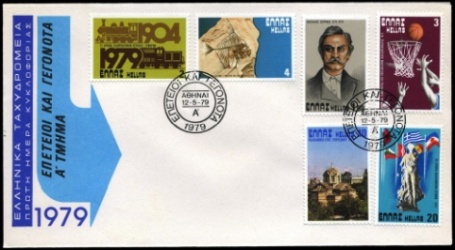
|
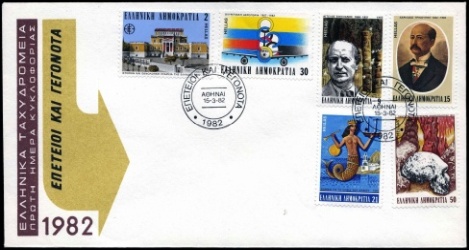
|
There are however, several personalized FDCs on the market, designed by dealers or collectors for each issue. Those personalized FDCs have relevant cachets, and are cancelled with the regular postmark for the first day of issue. Some covers may have a postmark with a date after the first day of issue.
[4] One of the stamps from the "World Environment Day: Geoparks of Greece" set shows some trunks of petrified trees from Lesvos Petrified Forest.
References:
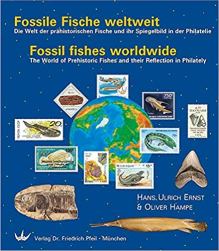
- [R1] Greece: Wikipedia WikiTravel FlagCounter
-
[R2] Postal History and Philately of Greece:
Wikipedia
Links to official website of the Post Authority, stamp catalog and a list of new stamps of Greece are here -
[R3] Mene psarianosi symeonidis:
Book "The World of Prehistoric Fishes and their Reflection in Philately", by Hans Ulrich Ernst, Oliver Hampe. Published in 2018. ISBN-10: 3899372417
Preview of some pages is here.
Amazon: USA, UK, DE - [R4] Petralona cave and Homo petralona: Wikipedia
Acknowledgement:
Dr. Peter Voice from Department of Geological and Environmental Sciences, Western Michigan University, for the draft page review and his valuable comments.
| << previous country | back to index | next country >> |